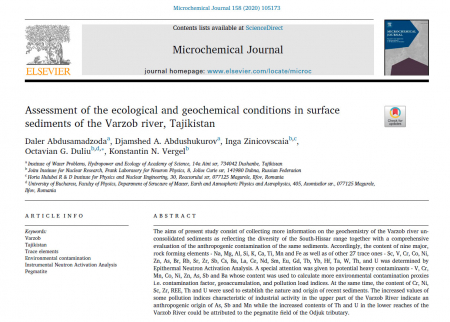A special attention was given to potential heavy contaminants - V, Cr, Mn, Co, Ni, Zn, As, Sb and Ba whose content was used to calculate more environmental contamination proxies i.e. contamination factor, geoaccumulation, and pollution load indices. At the same time, the content of Cr, Ni, Sc, Zr, REE, Th and U were used to establish the nature and origin of recent sediments. The increased values of some pollution indices characteristic of industrial activity in the upper part of the Varzob River indicate an anthropogenic origin of As, Sb and Mn while the increased contents of Th and U in the lower reaches of the Varzob River could be attributed to the pegmatite field of the Odjuk tributary.
Last modified on Душанбе, 21 Июн 2021Assessment of the ecological and geochemical conditions in surface sediments of the Varzob river, Tajikistan
The aims of present study consist of collecting more information on the geochemistry of the Varzob river unconsolidated sediments as reflecting the diversity of the South-Hissar range together with a comprehensive evaluation of the anthropogenic contamination of the same sediments. Accordingly, the content of nine major, rock forming elements - Na, Mg, Al, Si, K, Ca, Ti, Mn and Fe as well as of other 27 trace ones - Sc, V, Cr, Co, Ni, Zn, As, Br, Rb, Sr, Zr, Sb, Cs, Ba, La, Ce, Nd, Sm, Eu, Gd, Tb, Yb, Hf, Ta, W, Th, and U was determined by Epithermal Neutron Activation Analysis.
 Тоҷикӣ
Тоҷикӣ
 Русский
Русский  English
English 
